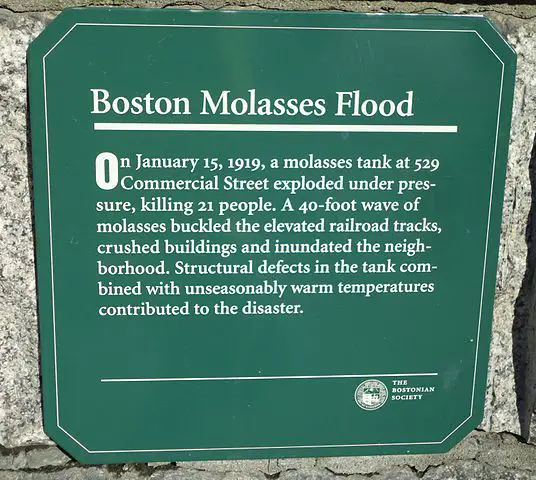A disaster occurred in the early 20th century that seemed improbable. The day was January 15, 1919, and just a little after midday, something terrible happened at the Purity Distilling Company in Boston, Massachusetts.
One of the company’s huge storage tanks that measured 90 feet wide (27 meters) and 50 feet in height (15 meters) suddenly collapsed. While the destruction of the tank was a disaster by itself, what it contained inside caused the real problems. When the tank went to the ground, it released more than 2.3 million gallons (8.7 million liters) of molasses.
The massive amount of spilled molasses created a wave that traveled down the streets of the city’s North End and caught everything and everyone in its path, which included people and horses. The wave of molasses destroyed buildings and killed 21 people while injuring 150 more. About half of those killed drowned or were killed by the crushing mass of liquid, while the others died in the following weeks because of the injuries they had sustained from the disaster.
It was reported that the wave of molasses reached 25 feet in height (7.6 meters) and moved at an astonishingly quick rate of 35 mph (56 km/h). No one could escape the sticky mass of liquid, and the more people and horses struggled to get out, the more they found themselves trapped.
Rescuers had difficulty reaching the victims of the flood and had to wade through waist-high molasses to get to them. The wave had upended freight cars and completely destroyed the firehouse of Engine 31. In all, the rescuers spent four days looking for survivors and recovering the deceased.
A class-action lawsuit was later brought on by those affected by the flood against the parent company of Purity Distilling, the United States Industrial Alcohol Company (USIA). The company claimed the tank had been blown up by anarchists. So what was the ultimate cause of the disaster?
It was revealed that the tank had been quickly constructed in 1915 and known to have leaked and been unstable. It was even known that USIA had the tank painted brown to hide the leaks. The tank had been filled 30 times since its construction and only filled to capacity four times. Present-day studies determined that the steel was most likely too thin to hold the volume of liquid.
After three years of litigation, a court-appointed auditor found that USIA was responsible for the disaster and was ordered to pay damages that reportedly amounted to around $7,000 per victim.
But why did a liquid that is known to move slowly become so dangerous to those people in 1919? Boston was 41 degrees Fahrenheit (5 degrees Celsius) on the day of the disaster. The molasses had been delivered from the Caribbean only a few days before the accident, and the temperature of the liquid was still warm at around 50 to 68 degrees Fahrenheit (10 to 20 degrees Celsius).
When the molasses exploded from the collapsed tank, it began to flow rapidly until the winter temperatures began to cool it down. This increased the fluid’s viscosity and turned it from a quickly moving fluid into a gelatinous mass. This is what proved to be so disastrous to those caught up in the wave of molasses and why it proved to be so difficult for rescuers to get to the victims. This is also why the molasses initially became such a destructive force and able to level buildings.
USIA never rebuilt the tank, and today the area in Boston is marked with a plaque that commemorates the day of the “Great Molasses Flood.”
Sources: History, Scientific American, Smithsonian, NY Times





